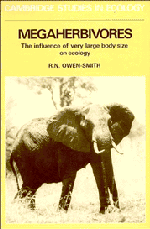Book contents
- Frontmatter
- Contents
- Preface
- 1 Prologue
- 2 Morphology, evolutionary history and recent distribution
- 3 Food and other habitat resources
- 4 Space–time patterns of habitat use
- 5 Body size and nutritional physiology
- 6 Body size and feeding ecology
- 7 Social organization and behavior
- 8 Life history
- 9 Body size and sociobiology
- 10 Body size and reproductive patterns
- 11 Demography
- 12 Community interactions
- 13 Body size and population regulation
- 14 Body size and ecosystem processes
- 15 Late Pleistocene extinctions
- 16 Conservation
- 17 Epilogue: the megaherbivore syndrome
- Appendixes
- References
- Index
12 - Community interactions
Published online by Cambridge University Press: 01 June 2011
- Frontmatter
- Contents
- Preface
- 1 Prologue
- 2 Morphology, evolutionary history and recent distribution
- 3 Food and other habitat resources
- 4 Space–time patterns of habitat use
- 5 Body size and nutritional physiology
- 6 Body size and feeding ecology
- 7 Social organization and behavior
- 8 Life history
- 9 Body size and sociobiology
- 10 Body size and reproductive patterns
- 11 Demography
- 12 Community interactions
- 13 Body size and population regulation
- 14 Body size and ecosystem processes
- 15 Late Pleistocene extinctions
- 16 Conservation
- 17 Epilogue: the megaherbivore syndrome
- Appendixes
- References
- Index
Summary
Introduction
In this chapter I consider relations between megaherbivore populations and other species, both plant and animal. How different would the community be, in its species composition, habitat physiognomy, productivity and other ecosystem level features, if megaherbivores were absent? The kinds of interactions of importance include (i) the predatory and disturbing impacts of herbivores on vegetation, (ii) competitive and mutualistic interactions among herbivore species, and (iii) the consequences of changes in species representation for ecosystem structure and function.
Impact on vegetation
Larger herbivores exert a direct impact on vegetation by their consumption of plant parts, and by breaking or trampling plants. Plants are damaged by the removal of leaves, bark and other parts, by breakage of branches, which depresses growth, and through being felled or uprooted, causing whole plant mortality. Even low levels of leaf loss may make certain species less successful in competition with other plants, or hold them in the height range within which they are vulnerable to fires. Bark removal may allow attack by wood-boring beetles and pathogens, increasing fire susceptibility. Felling may be fatal to certain plants, but not to others able to regrow by coppice regrowth of the stump. Selective herbivory could suppress the environmental dominance of certain species, providing opportunities for other species to increase. Heavy utilization of all or most species may depress plant biomass and hence primary production. If only the herb layer is heavily impacted, this reduces fire frequency, thereby favoring woody plant invasion.
Information
- Type
- Chapter
- Information
- MegaherbivoresThe Influence of Very Large Body Size on Ecology, pp. 226 - 245Publisher: Cambridge University PressPrint publication year: 1988
Accessibility standard: Unknown
Why this information is here
This section outlines the accessibility features of this content - including support for screen readers, full keyboard navigation and high-contrast display options. This may not be relevant for you.Accessibility Information
- 1
- Cited by
